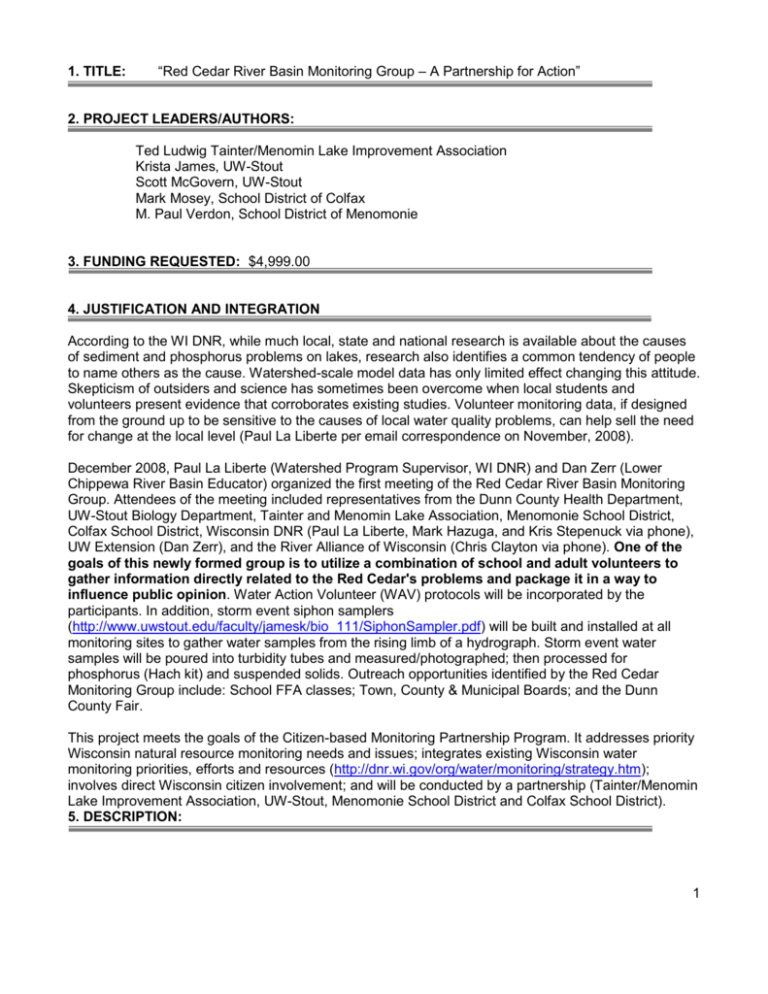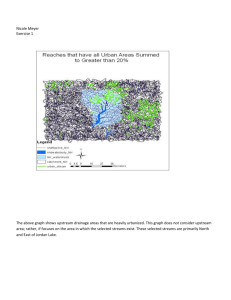“Red Cedar River Basin Monitoring Group – A Partnership for Action”
advertisement

1. TITLE: “Red Cedar River Basin Monitoring Group – A Partnership for Action” 2. PROJECT LEADERS/AUTHORS: Ted Ludwig Tainter/Menomin Lake Improvement Association Krista James, UW-Stout Scott McGovern, UW-Stout Mark Mosey, School District of Colfax M. Paul Verdon, School District of Menomonie 3. FUNDING REQUESTED: $4,999.00 4. JUSTIFICATION AND INTEGRATION According to the WI DNR, while much local, state and national research is available about the causes of sediment and phosphorus problems on lakes, research also identifies a common tendency of people to name others as the cause. Watershed-scale model data has only limited effect changing this attitude. Skepticism of outsiders and science has sometimes been overcome when local students and volunteers present evidence that corroborates existing studies. Volunteer monitoring data, if designed from the ground up to be sensitive to the causes of local water quality problems, can help sell the need for change at the local level (Paul La Liberte per email correspondence on November, 2008). December 2008, Paul La Liberte (Watershed Program Supervisor, WI DNR) and Dan Zerr (Lower Chippewa River Basin Educator) organized the first meeting of the Red Cedar River Basin Monitoring Group. Attendees of the meeting included representatives from the Dunn County Health Department, UW-Stout Biology Department, Tainter and Menomin Lake Association, Menomonie School District, Colfax School District, Wisconsin DNR (Paul La Liberte, Mark Hazuga, and Kris Stepenuck via phone), UW Extension (Dan Zerr), and the River Alliance of Wisconsin (Chris Clayton via phone). One of the goals of this newly formed group is to utilize a combination of school and adult volunteers to gather information directly related to the Red Cedar's problems and package it in a way to influence public opinion. Water Action Volunteer (WAV) protocols will be incorporated by the participants. In addition, storm event siphon samplers (http://www.uwstout.edu/faculty/jamesk/bio_111/SiphonSampler.pdf) will be built and installed at all monitoring sites to gather water samples from the rising limb of a hydrograph. Storm event water samples will be poured into turbidity tubes and measured/photographed; then processed for phosphorus (Hach kit) and suspended solids. Outreach opportunities identified by the Red Cedar Monitoring Group include: School FFA classes; Town, County & Municipal Boards; and the Dunn County Fair. This project meets the goals of the Citizen-based Monitoring Partnership Program. It addresses priority Wisconsin natural resource monitoring needs and issues; integrates existing Wisconsin water monitoring priorities, efforts and resources (http://dnr.wi.gov/org/water/monitoring/strategy.htm); involves direct Wisconsin citizen involvement; and will be conducted by a partnership (Tainter/Menomin Lake Improvement Association, UW-Stout, Menomonie School District and Colfax School District). 5. DESCRIPTION: 1 The Tainter/Menomin Lake Improvement Association (TMLIA), University of Wisconsin-Stout, Menomonie School District and Colfax School District have partnered to form the Red Cedar Monitoring Group. We formed this partnership to combine the efforts of a number of groups interested in education and incorporating the Red Cedar Watershed’s issues with water quality as an educational tool. Previous stream monitoring has shown that most of the nutrients and pollutants are not carried in large amounts during normal stream conditions (low water conditions). Instead, most solids and the associated nutrients are carried during rain events and spring melt. Through this new monitoring project, event sampling devices will be built and installed at approximately 50 locations in the Red Cedar Basin. The event sampling devices will capture the rising stream water during a storm event. After the event, the device is emptied and tests are conducted on the captured sample. Depending on the level of education (8th grade science, high school, and University) various tests will be conducted. Volunteers with the TMLIA will be monitoring various sections of the Hay River, Little Otter, Popple, Bronken, and Red Cedar River through the WAV program. Event sampling devices will be installed at each location to measure turbidity. Information will be forwarded to students at Menomonie, Colfax and Stout to be incorporated into presentations. Students at Menomonie Middle School will be monitoring Jarrett Creek, a small watershed of the Red Cedar River. Five stream study locations have been selected which include both rural and urban settings. The students will use the collected data (including photographs of water samples collected) and make presentations at various forums (County Meetings, Town Board Meetings, City Council, Public Library, Lake Fairs, and County Fair, etc.) This data will enable students to illustrate the consequences of land use practices in our community. At Colfax High School, Mark Mosey and his students propose to install river event samplers along various sites in the Eighteen Mile Creek Watershed. According to DNR data, the Eighteen Mile Creek Watershed has some of the highest phosphorus loads in the state. This data will be used by students to illustrate the consequences of land use practices in the Colfax area. Mark also plans to have his students share the collected data at public meetings, 4-H events, and local fairs. At the University Level, students of Scott McGovern and Krista James will install and monitor event sampling devices along Gilbert Creek and Galloway Creek. Both of these tributaries are currently being studied by both instructors using WAV protocols. UW-Stout students will either do their own presentations or assist high school and middle school students. A. Goals: 1. Provide a hands-on-learning experience that will apply science/environmental concepts while providing a service to community through water quality monitoring. 2. Students will understand the consequences of Land Use in the community in which they live. 3. To instill a sense of civic engagement among students and to empower them with the knowledge of how to implement improvement efforts within the community. B. Location / study area: The Red Cedar River Basin drains 1,893 square miles in west-central Wisconsin. The area includes parts of Barron, Chippewa, Dunn, Polk, Rusk, Sawyer, St. Croix and Washburn counties. Water quality problems related to phosphorus have been documented in the basin. High phosphorus levels cause 2 algal blooms and excessive plant growth in area lakes and contribute to low oxygen levels in streams. The Red Cedar River Basin Monitoring sites included in this Partnership Proposal include: Galloway Creek, Gilbert Creek, Jarrett Creek, 18 Mile Creek, the Hay River and the Red Cedar River. C. Methods Galloway Creek and Gilbert Creek UW-Stout students enrolled in BIO 111 will conduct water quality monitoring of Gilbert and Galloway Creeks using the Science, Society and the Environment Lab Manual created for the course (http://www.uwstout.edu/faculty/jamesk/bio_111/StreamMonitoring_Stout.pdf). Physical and chemical parameters measured will include stream flow, temperature, pH, dissolved oxygen, transparency, phosphorus, nitrate, chloride, and E.coli (petrifilm). Hach kits, pH meters, a dissolved oxygen probe, and storm event siphon samplers will be used. Macroinvertebrates will be collected using D-frame dip nets and identified to order or level. Jarrett Creek Menomonie Middle School Students will conduct stream monitoring using level 1 WAV protocols on 5 locations on Jarrett Creek. Physical and chemical parameters measured will include stream flow, temperature, pH, dissolved oxygen, turbidity, phosphorus, nitrates and ammonia. Hach kits, pH meters, a dissolved oxygen probe, and storm event siphon samplers will be used. Macro invertebrates will be collected using D-frame dip nets and identified to order or level Red Cedar River Basin Monitoring Group: stream monitoring sites 18 Mile Creek Colfax High School Students will conduct stream monitoring using level 1 WAV protocols on several locations in the 18 Mile Creek watershed. Physical and chemical parameters measured will include stream flow, temperature, pH, dissolved oxygen, turbidity, phosphorus, nitrates and ammonia. Hach kits, pH meters, a dissolved oxygen probe, and storm event siphon samplers will be used. Macro invertebrates will be collected using D-frame dip nets and identified to order or level. 3 TMLIA Locations Volunteers with TMLIA will conduct stream monitoring using level 1 WAV protocols on several tributaries of the Red Cedar River. Physical and chemical parameters measured will include stream flow, temperature, pH, dissolved oxygen, turbidity, phosphorus, nitrates and ammonia. Hach kits, pH meters, a dissolved oxygen probe, and storm event siphon samplers will be used. Macro invertebrates will be collected using D-frame dip nets and identified to order or level. D. Anticipated Results/Benefits Students will be monitoring streams and run-off events in the community in which they live and go to school. The students will be able to clearly see the impact that current land use has on our streams and lakes. Students will be able to prove that rural and urban storm runoff in our community does contain significant amounts of nutrients. Students will understand that we all have an impact on the delivery nutrients in our watershed. Through student presentations, and discussions around the dinner table, changes will be made slowly one student (one family) at a time. Due to the large number of students involved in these monitoring activities (several hundred) each year, the impact/potential for change is great. Through student-led presentations, the public will be better informed, healthier, and willing to make changes in land use practices. 6. PRODUCTS Construction and implementation of the event sampling devices will take place during 2009. These devices will be placed in locations of river habitats that feed the lakes and Red Cedar River in our area. Nutrients and other parameters will be measured and recorded. Baseline data collecting will continue to take place to show the nutrient load during normal stream levels. This data will provide information on the impact on water quality during precipitation events by collecting samples immediately after storms. Presentations by middle school, high school and college students will inform local organizations and the public about our area’s water quality issue helping other citizens make better choices. 7. COMMUNICATION PLAN A. Target Audience: The target audience is middle and high school science classes, university science classes, staff, families, and the communities of Menomonie and Colfax. B. Delivery: Presentations by middle school, high school and college students will inform local organizations and the public about our area’s water quality issue helping other citizens make better choices. 8. TIMELINE Spring 2009: Students collect baseline data at numerous stream sites, and a limited number of event sampling devices employed (permits have been applied for). 2009-2010 School Year: Over 50 event sampling devices installed and monitored. Continued fall and spring baseline data collected. 4 Spring 2010: Presentations by middle school, high school and college students will inform local organizations and the public about our area’s water quality issues. 9. ITEMIZED BUDGET BUDGET Column A Column B Column C Column D Total Amount Needed for the Project ($) Amount to be Paid by the Project Leader's Organization(s) ($) Amount to be Paid by Other Sources ($) Amount Requested from the CBM Partnership Program ($) Wages, salaries, stipends, etc. 0 0 0 0 Equipment and supplies $5, 250.00 $350.00 0 $3,999.00 Travel (mileage, lodging, per diem) $1,200.00 0 0 $1000.00 Total ($) $6, 450.00 $350.00 0 $4,999.00 Total Needed or Anticipated for the Project (hrs) Amount the Project Leader's Organization(s) Can Provide (hrs) Amount that is Certain Through Other Sources (hrs) Amount Still Needed (hrs) Box B: Box C: MONEY ($) DONATED TIME (HRS) Box A: Unpaid Staff & Volunteer Time 500 hrs 500 hrs Box D: 0 0 10. PROJECT PERSONNEL AND CONTACT INFORMATION Project Leader: Ted Ludwig, TMLIA ph. 715 962-3953 Science Instructor: M. Paul Verdon, SDMA Science Instructor: Mark Mosey, School District of Colfax oringted@charter.net michael_verdon@msd.k12.wi.us mosey@colfax.k12.wi.us Science Instructor: Krista James, Biology Dept; UW-Stout 715-220-7466 jamesk@uwstout.edu Science Instructor: Scott McGovern, UW-Stout mcgoverns@uwstout.edu 11. PREVIOUS CBM PARTNERSHIP PROGRAM FUNDING: None 5







